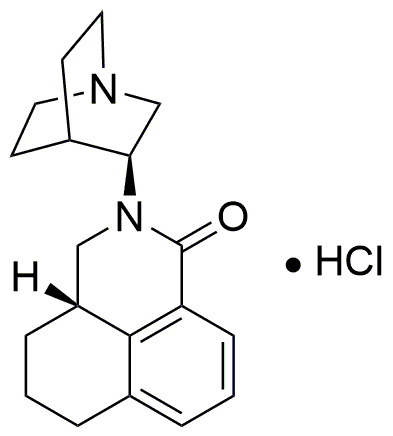Palonosetron hydrochloride is widely utilized in research focused on:
- Anti-Nausea Treatment: This compound is primarily used in the medical field to prevent nausea and vomiting associated with chemotherapy. Its effectiveness in blocking serotonin receptors makes it a preferred choice for patients undergoing cancer treatment.
- Clinical Trials: Researchers frequently employ palonosetron hydrochloride in clinical studies to evaluate its efficacy and safety in various patient populations, helping to establish best practices in antiemetic therapy.
- Pharmaceutical Development: The compound serves as a key ingredient in the formulation of antiemetic drugs, allowing pharmaceutical companies to develop more effective medications with fewer side effects compared to older agents.
- Combination Therapies: In oncology, palonosetron hydrochloride is often used in combination with other drugs to enhance overall treatment effectiveness, providing a comprehensive approach to managing chemotherapy-induced nausea.
- Patient Quality of Life Improvement: By effectively managing nausea, this compound significantly improves the quality of life for patients undergoing cancer treatment, allowing them to maintain better nutritional intake and overall well-being.
General Information
Properties
Safety and Regulations
Applications
Palonosetron hydrochloride is widely utilized in research focused on:
- Anti-Nausea Treatment: This compound is primarily used in the medical field to prevent nausea and vomiting associated with chemotherapy. Its effectiveness in blocking serotonin receptors makes it a preferred choice for patients undergoing cancer treatment.
- Clinical Trials: Researchers frequently employ palonosetron hydrochloride in clinical studies to evaluate its efficacy and safety in various patient populations, helping to establish best practices in antiemetic therapy.
- Pharmaceutical Development: The compound serves as a key ingredient in the formulation of antiemetic drugs, allowing pharmaceutical companies to develop more effective medications with fewer side effects compared to older agents.
- Combination Therapies: In oncology, palonosetron hydrochloride is often used in combination with other drugs to enhance overall treatment effectiveness, providing a comprehensive approach to managing chemotherapy-induced nausea.
- Patient Quality of Life Improvement: By effectively managing nausea, this compound significantly improves the quality of life for patients undergoing cancer treatment, allowing them to maintain better nutritional intake and overall well-being.
Documents
Safety Data Sheets (SDS)
The SDS provides comprehensive safety information on handling, storage, and disposal of the product.
Product Specification (PS)
The PS provides a comprehensive breakdown of the product’s properties, including chemical composition, physical state, purity, and storage requirements. It also details acceptable quality ranges and the product's intended applications.
Certificates of Analysis (COA)
Search for Certificates of Analysis (COA) by entering the products Lot Number. Lot and Batch Numbers can be found on a product’s label following the words ‘Lot’ or ‘Batch’.
*Catalog Number
*Lot Number
Certificates Of Origin (COO)
This COO confirms the country where the product was manufactured, and also details the materials and components used in it and whether it is derived from natural, synthetic, or other specific sources. This certificate may be required for customs, trade, and regulatory compliance.
*Catalog Number
*Lot Number
Safety Data Sheets (SDS)
The SDS provides comprehensive safety information on handling, storage, and disposal of the product.
DownloadProduct Specification (PS)
The PS provides a comprehensive breakdown of the product’s properties, including chemical composition, physical state, purity, and storage requirements. It also details acceptable quality ranges and the product's intended applications.
DownloadCertificates of Analysis (COA)
Search for Certificates of Analysis (COA) by entering the products Lot Number. Lot and Batch Numbers can be found on a product’s label following the words ‘Lot’ or ‘Batch’.
*Catalog Number
*Lot Number
Certificates Of Origin (COO)
This COO confirms the country where the product was manufactured, and also details the materials and components used in it and whether it is derived from natural, synthetic, or other specific sources. This certificate may be required for customs, trade, and regulatory compliance.


